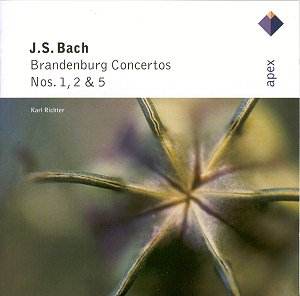The six Brandenburg Concertos, first printed in 1721,
represent relatively early works in Bachís canon. All were probably
compiled, at least in their early versions, by 1717, when he took the
post of Cappelmeister in Cothen. Every one of the concertos is a masterpiece
of sustained invention that tears up the conventions of the standard
concerto grosso form both in terms of harmonic complexity and professional
virtuosity.
The disc presents three of the concertos, nos 1, 2
and 5, led by the great conductor, choirmaster and organist Karl Richter
(1926-1981), who was for a time, like Bach before him, organist of the
Leipzig Thomaskirche. This is the first of his recordings, released
in 1958.
The first concerto is arranged for hunting horns, oboes,
bassoon, strings and continuo. From the opening movement it is immediately
apparent that the brass section is too quiet, and, at times almost inaudible.
The violins are overly prominent, which robs the music of its richness.
Indeed the horns should play a crucial role here, initially clashing
rhythmically with the strings, later assimilated into the harmony to
produce an elegant ending. Unfortunately this is lost and the overall
impression is not favourable. The notes specify that concertos 1 and
5 have been electronically "converted" from mono to stereo,
which may have caused this effect.
The second movement (adagio) contains a beautifully
played oboe part, although the tempo in this recording may be a little
slow for some. The third (allegro) is also a joy, the strings
playful and realistic, although let down again by the indistinct horns.
The delightful fourth movement is comprised of a series of dances, and
Richter shines here. The oboes and bassoon in the first trio weave an
elegant dance around each other, while the horns and oboes play a hunting
melody without strings in the second. These interludes are interspersed
around an elegant repeated minuet and polonaise. There is much to enjoy
in this performance of concerto 1, but I would not recommend it as a
first choice for a recording on modern instrument. Instead, I would
suggest Brittenís set on Decca from 1968.
Concerto no. 2 is written for trumpet, recorder, oboe,
strings and continuo. The first and third movements are real lip splitters
for the trumpeters. Here, the solo playing is of a very high order,
but there are problems with the ensemble, at least one violin not quite
in tune. The following andante is quite the most beautiful performance
on the disc, however, and as perfect a realisation of this simple but
immensely affective piece that I have heard. The third movement, once
again, has a superbly played trumpet line which rounds off the work
with great energy.
Concerto 5, although scored for a more modest group
of instruments (flute, strings and harpsichord), contains some of Bachís
lushest and most romantic music. There is a great dignity to the strings
and flute parts in the opening section, which eventually give way to
an extended harpsichord candenza that is relatively ugly and lifeless.
The wonderfully scored affectuoso is also a disappointment, played
at a very slow tempo which renders it dull. Finally, the allegro,
a playful fugue, rescues the performance from mediocrity. The flute
section is very light and the strings assured, providing an impressive
finish to a problematic performance.
Overall, I cannot recommend this recording, particularly
to those unfamiliar with these magnificent creations. However, Richter
did revisit the Brandenburg Concertos in 1967, to a far more impressive
effect. It should also be noted that the chamber orchestra was, at the
time, several years short of developing into one of the great ensembles,
the Munich Bach Orchestra. Those who have the later set may want these
performances as a comparison set, but Iím afraid that they are best
avoided by the uninitiated.
Peter Bright

